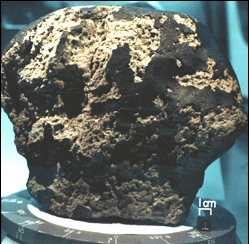meteorites from Mars

Martian meteorite EETA79001 recovered from Elephant Moraine, Allen Hills, Antarctica. Photo: Lunar and Planetary Institute.
More than 100 meteorites have been found on Earth that have come from Mars, having been ejected from that planet millions of year ago by asteroid collisions. All are igneous rocks that formed by crystallization of cooling magma in the martian crust. As such all are achondrites formed by differentiation in their parent body rather than primitive chondrites formed by accretion of chondrules in the early solar nebula. Martian meteorites have many similarities to HED achondrites and were grouped with HED meteorites until their young crystallization ages and distinct oxygen isotope trend defined them as a distinct group known as SNC meteorites. This group includes the shergottites, nakhlites, and chassignites.
The SNC group was named after the type samples of the first three rock types: basalt Shergotty, clinopyroxene cumulate Nakhla, and olivine cumulate Chassigny. As more samples of the group were identified, some of them fitted well into the existing types; for example, Zagami and EETA79001 as shergottite basalts and Lafayette and Governador Valadares meteorites as nakhlite cumulates. ALHA77005, however, was found to be related to shergottites, but be a cumulate rather than a basalt. It was nonetheless classified as a shergottite. By 1985 the discovery of martian atmosphere trapped inside EETA79001 had convinced many meteoriticists that the SNC meteorites were from Mars.
Family groups
There are now five distinct igneous rock types in the martian meteorite family. Bulk compositions are generally consistent with mineralogy. Shergottites are divided into pyroxene-plagioclase basalts (S-B) and pyroxene-olivine lherzolites (S-L). Nakhlites (N) are clinopyroxene cumulates. Chassigny (C) is an olivine cumulate or dunite and ALH84001 is an orthopyroxene cumulate (O). The first three types are populated by multiple samples, ALH84001 and Chassigny are singular members of their classifications. Because Mars is a complex planet one can expect that as more martian meteorites are identified, new rock types will continue to be found.
The most famous martian meteorite
ALH84001, which became the center of a major controversy in 1996 when a group of NASA scientists claimed it contained fossils and other biological remains, was initially misclassified as a diogenite (orthopyroxene cumulate) because it fitted well into that mineralogical classification and because the SNC meteorites were presumed to be limited in their lithologies. In 1993 it was found to contain oxidized iron in its accessory oxide phases, in contrast with the reduced iron in the oxides of HED meteorites. This implied that ALH84001 came from a volatile-rich Earth-like planet rather than a volatile-poor asteroid. Oxygen isotope analyses proved that it was a part of the SNC family even though it is not a member of any of the three types.
More recently two other martian meteorites, Nakhla and Yamato 593, have been found to contain what appear to be biomorphs (suspected fossil forms) and other evidence for past life, including chains of magnetite crystals and carbonates deposited from at moderate temperatures. The age spread of ALH84001, Nakhla, and Yamato, from 3.6 billion to 1.4 billion yr ago, suggests that life was present on Mars throughout that period, and may still exist there today. See martian fossils controversy and life on Mars.
From Mars to Earth
In The War of the Worlds, H. G. Wells imagines the Martians firing their invading ships Earthward out of a great cannon (much like the Columbiad of Jules Verne's lunar classic). But could a natural collision similarly have blasted pieces of Mars into space? Photos of the martian surface taken by the Viking orbiters revealed scores of craters that are obviously the result of oblique impacts. One of these is a crater measuring 14 by 31 kilometers, located at the southern approaches to a volcano known as Ceraunius Tholus, about 950 kilometers west of the Viking 1 landing site. Conceivably, some of the lava that flowed out of this volcano, 1.3 billion years ago, cooled to form the basalt contained within EETA 79001, although a number of other craters have also been identified as possible sources of the rock.
The mechanics of how SNC meteorites might have been ejected were first investigated in detail in the early 1980s by Laurence Nyquist at the Johnson Space Center in Houston. A large object striking Mars at 35,000 kilometers per hour could, he showed, hurl material from the surface at a speed in excess of the 18,000 kilometers per hours martian escape velocity. In fact, his calculations revealed, the escape velocity would be easily surpassed if heat from the impact vaporized permafrost below the martian surface and so gave rise to a massive gas explosion. These conclusions were confirmed by the work of John O'Keefe and Thomas Ahrens at the California Institute of Technology in 19861 (see ballistic panspermia).


